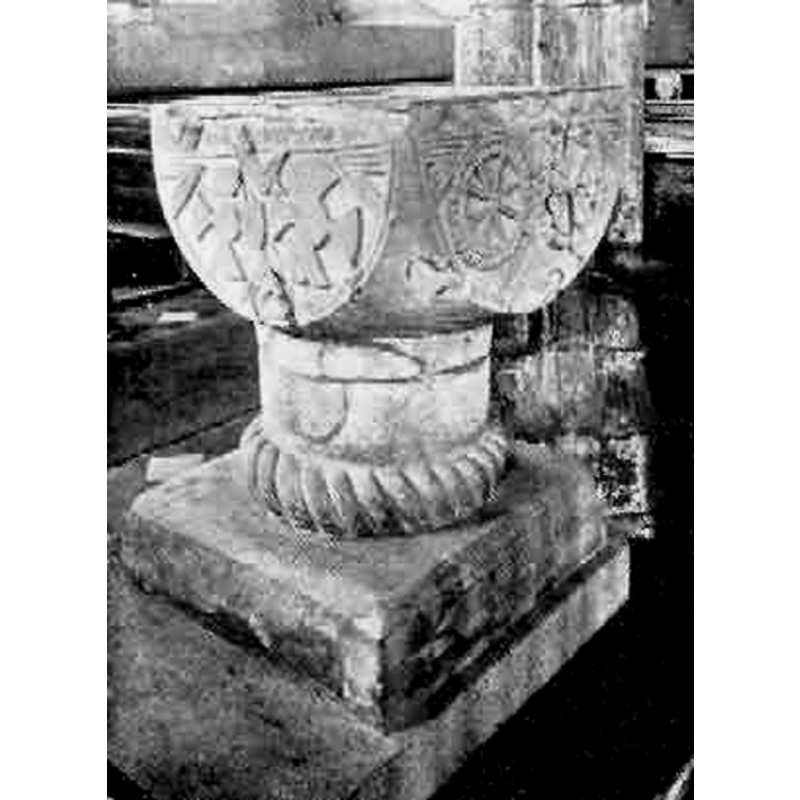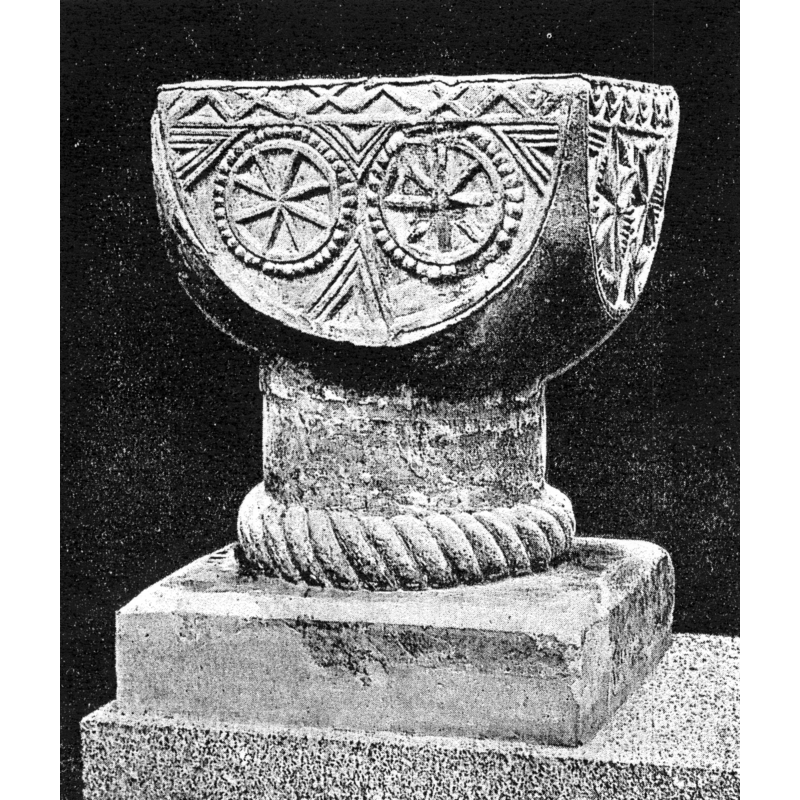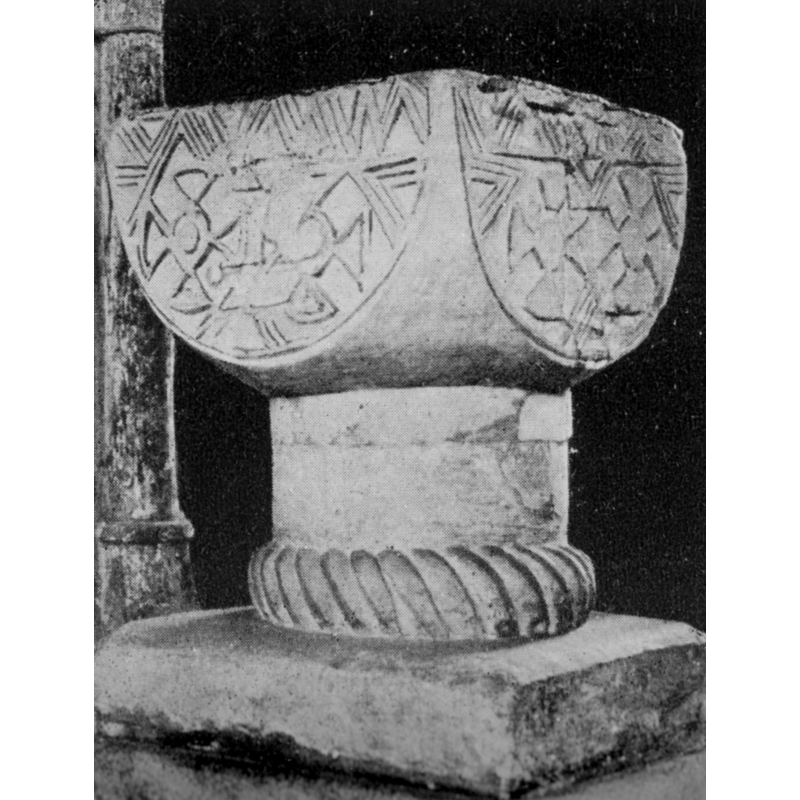High Bickington

Image copyright © Roger Peters, 2005
Permission received (email of 9 January 2005)
Results: 9 records
B01: design element - motifs - wheel - 8-spoke - beaded-tape circle
B02: symbol - cross - Greek - Maltese - rounded arms - 4
B03: design element - motifs - floral
Scene Description: the motifs on this east side are much restored, but Clarke mentions "two large four-leaved flowers" [NB: the photograph is probably dated pre-1902, the date of the restoration that removed all the iron clamps from the font]
Copyright Statement: Image copyright © [in the public domain]
Image Source: digital image of an illustration in Bond (1908) [NB: the photograph is probably dated pre-1902, the date of the restoration that removed all the iron clamps from the font]
Copyright Instructions: PD
BBU01: design element - motifs - zigzag, herringbone or chevron?
LB01: design element - motifs - rope
view of font
view of font
view of font
INFORMATION
FontID: 05096BET
Object Type: Baptismal Font1
Church/Chapel: Parish Church of St. Mary
Church Patron Saints: St. Mary the Virgin
Country Name: England
Location: Devon, South West
Directions to Site: Located in north Devon
Font Location in Church: Inside the church [Bond reported it found in a barn]
Century and Period: 12th century (late), Late Norman
Credit and Acknowledgements: We are grateful to Dr. Roger Peters, of www.wissensdrang.com, for his permission to use the transcription of and images from Stabb (1908).
Font Notes:
Click to view
An entry in the 'Devon Notes and Queries' (1902) [cf. infra] gives an interesting description of the font and the unhappy and unsuccessful attempts at its preservation. It is described and illustrated in Bond (1908) as a Norman baptismal font of the late 12th century; the square basin is shaped like a cushion capital, each of its vertical sides ornamented with two large medallions containing a large wheel, and some herringbone and or chevron motif; the underbowl is rounded; the cylindrical stem of the base is plain but it has a thick rope moulding at its bottom where it joins the square lower base. This font, notes Bond (ibid.), "was found in fragments in a barn", and his illustration shows a large vertical crack right up to the top, equally broken at the upper base and at the lower base. Described and illustrated in Stabb (1908): "The font and south porch are Norman […] The Norman font has been restored [...]; it was in a very dilapidated condition, only kept together by bolts of iron. A remarkable feature is its being composed of only two blocks of stone, the square base and half the shaft being cut out of one block, and the bowl and the other half of the shaft are cut out of the second block. The bowl, which takes the form of a cushioned capital, is well carved, and there is cable moulding around the base of the shaft." Described and illustrated in Clarke (1919), who identifies the ornamentation on the sides: "North: two Maltese crosses, the ends of the arms rounded, so as to produce a circular effect. Both are damaged and repaired; the fragmentary one on the right shows that each arm has a triangular hollow, following the outline, which remains as a square-edged rdge. As background to the crosses, there are chevrons, incised diagonal lines, and raised bands with deep hollows between, all arranged in an arbitrary way, without any attempt at pattern. West: similar in design, but the crosses are only roughed out, their shape is the same as in the northern face, but there is no ornamentation of hollows. The chevrons and lines are less determinate, and the whole face appears to be somewhat unfinished. South: instead of crosses there are two wheels of eight spokes, each enclosed in a circle of pearls, with chevrons in the interspaces. At the top edge is band of raised zigzag and crosses, 2 1/2 inches deep. The eastern face has had to be much restored. There are two large four-leaved flowers about ten inches in diameter; the leaves project beyond a circle of pellets. Chevron in the interspaces, and a band at the edge of scallop and pellets. About three inches of the shaft is cut in the same block as the bowl, it is rather larger than the rest of the shft, so that the appearance of a necking is produced. At the foot of the shaft is a cable, five inches deep. The material of the font is a cream-coloured stone of a crumbling nature." Clarke (ibid.) informs that the font was repaired and restored in 1902, and makes reference to an "intesreting account of it (unsigned) published in Devon Notes and Queries, Vol. II, No. 109, p. 145. The writer states that before restoration the font was in forty-five pieces, partly through the use of iron clamps which had been let in to hold it together, but which disintegrated it instead. The actual metal removed weighed 16 1/2 punds". Described in Pevsner (1952): "Font. Norman, square, like a large block-capital. The semicircular surfaces decorated with large wheels, rosettes, and crosses, two motifs to each side." [We are grateful to Dr. Roger Peters, of www.wissensdrang.com, for his permission to use the transcription of and images from Stabb (1908)]
MEDIUM AND MEASUREMENTS
Material: stone
Font Shape: square (mounted)
Basin Interior Shape: round
Basin Exterior Shape: square
Drainage Notes: lead lining [reported in ca. 1902]
Rim Thickness: 7.5 cm [calculated]
Diameter (inside rim): 45 cm*
Diameter (includes rim): 60 cm*
Basin Depth: 25 cm*
Basin Total Height: 37.5 cm*
Height of Central Column: 21.25 cm*
Font Height (less Plinth): 72.5 cm*
Notes on Measurements: * [measurements given in inches in Clarke (1919: 221)]
REFERENCES
Bond, Francis, Fonts and Font Covers, London: Waterstone, 1985 c1908
Clarke, Kate M., "The baptismal fonts of Devon -- Part VI", 51, Report and Transactions of the Devonshire Association for the Advancement of Science, Literature and Art, 1919, pp. 211-221; p. 212, 214-215, 221 and pl. II (opp. p. 215)
Pevsner, Nikolaus, North Devon, Harmondsworth: Penguin, 1952
Stabb, John, Some old Devon churches, their roods, pulpits, fonts, etc., London: Simkin, [et al.], 1908-1916
[anonymous], "[Baptismal font at High Bickington]", II, 109, Devon and Cornwall Notes & Queries, 1902, pp. 145; p. 145 and pl. on opp. p.


![the motifs on this east side are much restored, but Clarke mentions "two large four-leaved flowers" [NB: the photograph is probably dated pre-1902, the date of the restoration that removed all the iron clamps from the font]](/static-50478a99ec6f36a15d6234548c59f63da52304e5/compressed/0041220001_compressed.png)